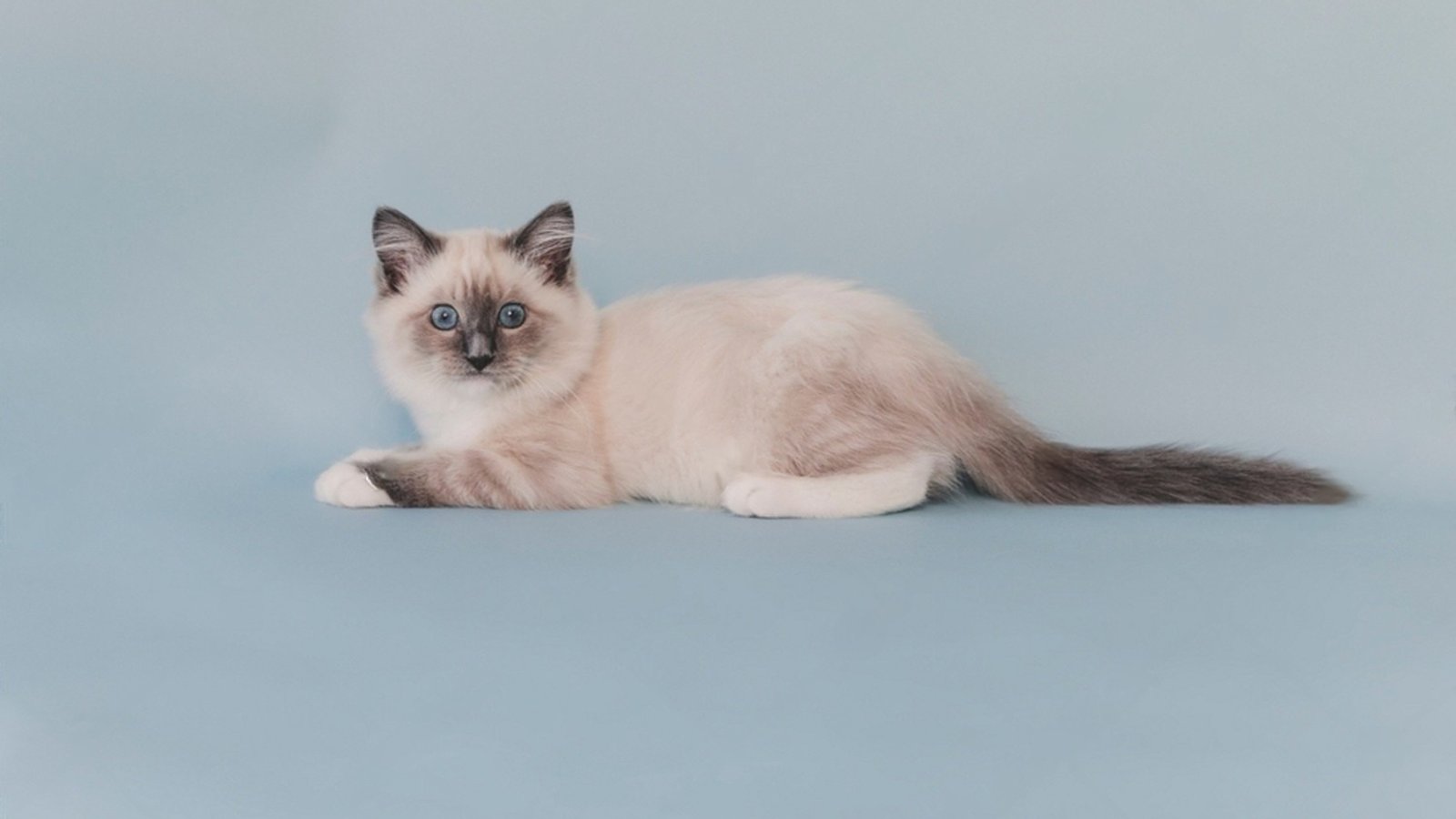Blue mitted ragdoll cat isn’t a new breed nor is it a subset like a mink ragdoll cat, though it’s one of the six colors and three patterns in traditional ragdolls. The term “blue” refers to its bluish-grey points (snout, ears, face, tail, and legs) whereas the “mitted” points to the pattern (white boots on the front legs and white socks on the hind legs, white chin, and a belly stripe.)
In turn, the crumble effect of the coloration along with blue eyes and laid back temperament is what makes blue mitted ragdolls aesthetically pleasing and so sought after. Read on to learn everything about blue mitted ragdoll cat color and pattern, genetics, appearance, the differences with blue lynx mitted ragdolls, and how to look after them.
Blue Mitted Ragdoll Cat Breed Overview
- Weight – 10-20 lbs (6.80-9.07kg)
- Height – 23-28 cm (9-11 Inches)
- Length – 40-52 cm (16-21 Inches)
- Life Expectancy – 12-17 years
- Personality – Laid-back, playful, affectionate, Placid, loyal.
- Get Along Well With – Solo, couples, families with kids & other pets.
Blue Mitted Ragdoll Cat Characteristics – Color and Pattern
- The primary coat color of a Blue Mitted Ragdoll cat is a pale, silvery blue that covers most of the body. Mitted Ragdolls are the same as colorpoint ragdoll cats, aside from the ‘mitted pattern’ on their paws.
- The face of blue mitted ragdolls features a mask-like pattern that covers the snout, around the eyes, and across the face. They can have even a blaze on their nose often forming an hourglass shape, made up of either one line or a broken line along the nose bridge though. It should be focused central and symmetrical.
- The front paws of blue mitted ragdolls are usually of snow white color and you’ll see white boots over their back feet that go halfway up to the hocks though not over their thighs. Their ring-like tail coloration is darker with an even darker tip near the end.
- Interestingly, their chin and chest also have diluted pigment that gives them white color (hence they are also named blue point mitted ragdoll cats) which progresses to a white stripe that runs right down their belly. Meanwhile, the hind end, flanks, and saddle are set off by a soft grey hue.
Genetics Of a Blue Mitted Ragdoll Cat

Like traditional ragdolls, the blue point mitted ragdoll cat starts off fully white when they’re born with no manifest markings. You’ll start seeing their pointed color coming in around 2 weeks old as their cooler body temperatures activate pigment in their extremities (ears, face, paws, and tail). The color however continues to develop until they are two years old.
Dilution genes
For the coat to appear blue, the blue mitted ragdoll must inherit two copies of the recessive dilution gene (dd). This gene dilutes black-based pigments, like those in seal-point ragdolls, into a lighter, cooler grey “blue (fancy term for a grey hue)” shade.
White spotting genes
As for the mitted pattern, this isn’t determined by a separate “mitt” gene per se but by the expression of white spotting factors. Mitted ragdolls exhibit white markings on their front paws (called “snow white front feet”), back paws, chin, and parts of the belly.
This pattern stands up from the dominant white spotting allele, which drives specific areas of the coat to lack pigment. Unlike the high-white bicolor ragdolls, the mitted pattern restricts most white to specific areas and lets the blue point color remain in-tact on the rest of the body.
Colorpoint Genes
These cats carry the temperature sensitive colorpoint (cs) genotype that you know remains inactive until the cooler part of the ragdoll cat blue point mitted body triggers its expression. This gene plopped the production of melanin in cooler spots and gave it a classic pointed pattern on the ears, face, paws, and tail.
If we put it all together, it’s safe to say, that the interplay of the cs gene, dilution gene, and white spotting allele is what behold the distinctive blue mitted ragdoll cat that everyone loves to have around.
Blue Mitted Ragdoll Cat Personality & Temperament
Blue mitted ragdolls are pedigree cats (TICA & CFA registered) with very affectionate and chilled out personalities. They’ll be happy to follow you around the house, play fetch with any Ragdoll toy you toss, and melt into your arms when you scoop them up for a cuddle.
When you pick them up, they’ll go limp in your arms like a rag doll (hence the name) and are content to be held for hours. The obvious reason people get attracted to Blue Mitted Ragdoll cats in the USA and around the world is that they get along nicely with kids and cope with other pets in the house.
Though, they don’t like traveling (whether by car or air travel, as it can stress your kitty out) and being left alone for over 8 hours a day. They’re temperature sensitive so we recommend not to let them go outside, especially on their own if the weather is below 45F or at the very least, 32°F.
How To Care For a Blue Mitted Ragdoll Cat
Healthy Diet
Blue point mitted ragdolls are a bigger domestic breed and so do need meat-based food rich in protein (50%+), good moisture, and low carbs. We put first vet consultation to get a proper diet plan according to your mitted blue ragdoll age, sex, activity level, and overall health.
Ideally, ragdolls (whether you’ve got chocolate, blue mitted, lilac, or blue mitted mink) thrive well with either wet food or wet-dry mix. This satisfies their daily calorie intake (250-300 Cal) and their metabolism.
Grooming Sessions
Blue mitted ragdoll cats boast a semi-long haired coat that sheds naturally, especially in spring and fall or when high humidity sets in. To cut down on shedding, brush their hair twice a week with a delicate slicker brush and wide tooth comb. Trim their claws bi-weekly and routinely inspect their eyes and ears to keep them in check.
Bathing isn’t so necessary since blue mitted ragdoll cats are usually indoor pets and good at keeping themselves clean for the most part. If however they get into something nasty or their coat build up oil excessively you do need to bathe them (once a month is more than enough) with ragdoll-friendly shampoo.
Health Care
No pet parent wants to see their kitty suffer and as a matter of fact, blue mitted ragdoll cats are prone to polycystic kidney disease (PKD) and hypertrophic cardiomyopathy (HCM). Regular vet checkups help spot any issues beforehand and get them treated.
Choose a reputable vet who is close by or one that’s recommended by other ragdoll cat owners in your area. Keep their vaccination schedule up-to-date, and microchip them as soon as you get your blue mitted ragdoll kitten home.
Playtime & Exercise
Although blue mitted ragdolls aren’t overly energetic cats, they’re attention seekers who crave play and lots of human interaction. 15-20 minutes daily healthy playing session with interactive toys and scratching posts help them release pent-up energy and work out their muscles.
How Much Does a Blue Mitted Ragdoll Cat Cost

The price of a blue mitted ragdoll kitten can vary widely from location to location or breeder legitimacy. On average, a well-bred kitten from a reputable breeder costs between $3000-5000. This mostly includes pedigree papers, initial vaccination, and genetic health guarantees.
Although it’s okay to bring your first blue mitted ragdoll cat from a reputable breeder, if you decide to adopt one, be sure to thoroughly investigate the shelter’s legitimacy to avoid big scams.
On adoption platforms, fees are generally somewhere around $400 to $1,000. It by the way covers spaying or neutering, initial vaccines, and microchipping for cat ID. Whatever option you go with, expect to pay around $265 to $750 monthly to cover food, toys, treats, grooming supplies, and vet visits costs.
Blue Mitted Ragdoll Cat vs Blue Lynx Mitted Ragdoll Cat
Both the blue mitted ragdoll and blue lynx mitted ragdoll cat share a soft grey (“blue”) body color and signature white mittens on all paws. The significant difference lies in their facial markings. The blue mited ragdoll has solid “pointed” face with subtle shading around the eyes and nose. Meanwhile, the blue mitted lynx ragdoll cat features additional tabby-like stripes (lynx markings) across its face including a mask-like pattern around the eyes and faint “tabby” lines on the cheeks. These stripes stem from the lynx point gene and add a bold, wild-inspired twist to the classic Ragdoll look.
Difference Between Blue Point and Blue Mitted Ragdoll
If you compare a blue point ragdoll cat to a blue mitted ragdoll head-on, the only unlikeness you’ll pick up is the mitted white feet. Both pedigree cats hold colorpoint genes that give off their darker points color and lighter grey shade all over the body though. The mitted pattern adds white mittens on both front and back paws along with white belly stripes in blue mitted ragdoll cats.
Wrapping Up…
All in all, with bluish grey body color and signature white mittens, blue mitted ragdolls are nothing less than exquisite. They’re docile, friendly and so easy to care for. They’re good companions for families with children as long as you’ve trained your kids how to handle big cats. We do hope the info we’ve shared helps you know your blue mitted ragdoll cat better whether it’s their appearance, genetics, cost, personality, or caring in the best way possible.
Written By: Usman Malik | Reviewed By: Ali Abbas | Fact Checked By: Aqib Zulfiqar








